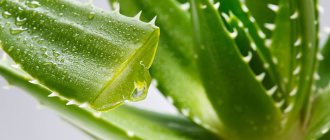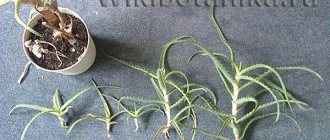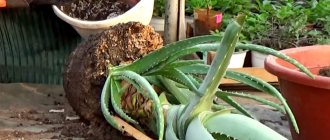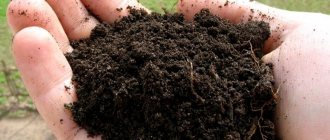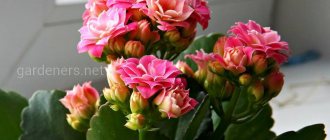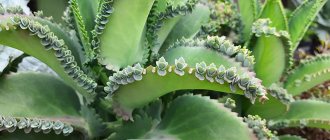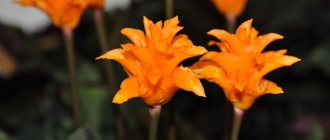Aloe spinosa is a plant belonging to the genus Aloe. Most often it can be seen in pots or flowerpots at home gardeners. The homeland of the culture is considered to be the regions of the Republic of South Africa, located in the east of the state, and the Kingdom of Lesotho, located in the southern part.
The leaves of the crop are collected in a rosette, and their arrangement is spiral-shaped. If you touch the coil, you can feel that its surface is rough and dense, with spines along the edges. The foliage turns into a thin thorn.
The stem is small, one might even say that it does not exist. The length of the rosette reaches up to 20 cm, and the leaves - 10 cm. When aloe spinosa does not bloom, it can be confused with another plant - haworthia.
Planting/growing
Experienced flower growers claim that growing this crop does not require much effort, so even a beginner can cope. The main thing is to follow the basic rule: be sure to add sand and drainage to the soil. Crushed red brick, shards or expanded clay are suitable for the latter.
As for the soil, it is not necessary to buy a special soil mixture, since any soil mixture will do, even leftovers from other crops. The container for aloe should be low but wide. Replantation must be done every year.
Caring for aloe after propagation
- Immediately after planting, place the plant in a cool place. Protect the crop from direct sunlight. Then place the container with the plant on a sunny windowsill.
- Water the plant 1 or 2 times every 7 days, when the top layer of soil dries. For watering, use settled, warm water.
- To remove accumulated dust from the leaves, wipe them with a damp piece of cloth. No need to spray.
- Maintain the room temperature at least +20°C in spring and summer. But in winter the temperature should not fall below +14°C.
- Constantly ventilate the room in which the plant is located.
- If you use special soil during planting, then do not fertilize for 8 or 9 months.
- Inspect the young plant to ensure there are no pests or diseases. If any appear, for example, thyroid gland or aphids on the leaf plates, then wipe them with a cotton swab, moistening it in alcohol before the procedure. You can also spray the plant with a composition made from garlic.
If you adhere to the rules that we described above, then the propagation of this amazing flower will be crowned with success. This culture takes root well, and therefore even novice gardeners can get young seedlings.
Temperature
The culture adapts quite well to high indoor temperatures. For example, the plant will calmly survive a thermometer reading of 24-28 degrees with a plus sign, so in the summer you can take a pot of aloe spinosa to the balcony without fear of harming it. On the contrary, fresh air has a positive effect on perennials, strengthening them.
But in winter, the room temperature should vary from 12 to 18 degrees Celsius. If the indicator reaches +10 degrees, then the development of the flower is inhibited and it may even die. In addition, it is important to avoid drafts.
If we talk about the air humidity in the room, then this parameter is not particularly important. Some house plant lovers try to spray aloe, but this is not necessary. Moreover, this procedure can only cause harm if water gets into the crop outlet and stagnates there. As a result, the plant will begin to hurt.
Aloe spinosa - what kind of flower is it?
Aloe aristata is a solitary herbaceous plant in the form of a bush. Short stems form groups of rosettes. The grey-green lanceolate leaves are covered with swollen white dots. At the tops there are white bones that break off with age. The number of leaves in one rosette can reach up to a hundred, and their length during growth can increase to 10-15 cm.
Aloe spinosa
A plant that is often confused with aloe spinosa is hawortia herbacea. Main differences:
- has no awns on the tops of the leaves;
- more compact;
- the appearance of daughter plants does not interfere with the growth of the mother plant;
- longitudinal pattern on the top of the sheet.
What does Haworthia look like?
Medicinal properties of aloe aristata
Aloe spinosa contains amino acids, flavonoids, vitamins and beneficial microelements. Healing and antibacterial drugs are made on its basis. Aloe juice is used to treat inflammatory diseases, and cosmetologists use it in masks, shampoos and other care products. Aloe juice helps regenerate and moisturize the skin.
Additional Information! In folk medicine, aloe is used in its pure form: a leaf with a longitudinal cut is applied to the site of injury and bandaged. For colds, aloe juice is mixed with honey and consumed orally.
Watering
The perennial is not afraid of droughts, since in its homeland it often encounters them, and therefore is well adapted. Aloe spinosa is afraid of excess moisture. But if in winter the pot is in close proximity to a heating device, then the flower should be watered a little more often than usual.
For irrigation, it is allowed to use only water at room temperature. The ideal option is for it to sit for several days beforehand. After each watering, the soil needs to be loosened a little. But the crop cannot be sprayed under any conditions, so the liquid is applied only at the root. This should be done very carefully so that nothing gets on the leaves and rosette.
Caring for aloe spinosa at home involves watering in late spring and summer, when the soil has dried by 1.5 cm. In winter, one irrigation per month is enough. If necessary, the leaves can be wiped off dust with a wet cloth, but no more.
Description of spinous aloe
The plant belongs to the genus Asphodelaceae, as it is a succulent. It grows in the form of rosettes with thick, fleshy leaves. Along the edges of which there are small spines. The plant itself is dark green with a scattering of white peas.
Main characteristics
Aloe aristata often grows up to 20 cm. The leaf length does not exceed 10 cm. One Aloe rosette can reach 60 cm in diameter. In 1 year, 5 to 10 new leaves grow. Aloe Aristata blooms with yellow or orange flowers, tubular or elongated in shape. Rising above the rosette on a long peduncle.
Under what conditions does it grow?
Aloe Aristata is a fairly unpretentious indoor flower. He is quite calm about dry air. But it does not like sudden changes in temperature. Aloe should be placed in a well-lit place, preferably on a windowsill.
Important! If the plant is placed away from the window for a long time, it may die.
Medicinal properties of succulents
Aloe has many beneficial properties, thanks to which the plant is used in cosmetology and medicine. Its juice has certain bactericidal properties due to amino acids such as glycine, leucine, lysine, etc. It also contains many different flavonoids, polysaccharides, zinc, chlorine and iron.
The most common uses:
- Medicine. The juice of the plant is used for disinfection and rapid healing of wounds, burns, etc.
- Alternative medicine. Its adherents believe that the plant helps with vitamin deficiency. It can also be used to treat vision problems.
- Cosmetology. Aloe is used in the preparation of various cosmetics both in production and at home. Aloe juice can be applied directly to the skin. This allows you to reduce inflammation and cleanse problem areas.
Important! When using aloe juice, it is imperative to test for an allergic reaction.
Light
This type of culture is heat-loving, so it loves the sun. At the same time, if you place a pot of aloe spinosa in the shade or in the northern part of the home, its growth will slow down. Therefore, it is important to avoid shady places. But still, in the summer heat, flower growers recommend covering the crop from the sun's rays to protect the rosette from yellowing.
In autumn and spring, fluorescent lamps should be turned on for 2-3 hours. During the growing season, light is needed bright, but at the same time diffused.
Description
Aloe spinosa belongs to the succulents of the Xanthorrhoeaceae family. Thick fleshy leaves are arranged in a spiral, gathering into powerful rosettes with a diameter of up to 60 centimeters.
Rough leaves, strewn with white dots, have spines along the edges and at the end. This feature can be read in the name Aloe spinosa. The flowers are tubular, orange with a yellow tint. Flowers are placed on an elongated peduncle. The roots have branches.
Feeding
Aloe spinosa, when growing in the wild, easily finds food for development and growth in the desert and stones. But, if it is grown at home, it needs feeding in the summer.
Ready-made complexes for cacti can be used as fertilizer. But before use, it is important to read the instructions so as not to exceed the dosage. This condition is important to fulfill, since an excess of nutritional components has a detrimental effect on the decorative effect of the flower. Fertilize after each watering every 14 days.
Flowering and dormant period of Aloe aristata
Aloe flower - what it looks like, types and care
At the end of spring or early summer, Aloe spinosa begins to bloom. It produces a long stem on which is located an inflorescence consisting of oblong flowers. Their color is yellow, scarlet or orange.
Aloe aristata blooming
In winter, the plant stops developing. Therefore, during this period it is transferred to a cool room and watering is reduced. No fertilizing is done at all in winter. After such conditions, the likelihood that aloe will bloom in the spring increases.
Additional Information! The succulent grows 8-9 leaf blades per year.
Pot
Aloe spinosa is an indoor plant that is planted in a container with a diameter several centimeters larger than the expected size of the rosette. The height of the pot should not be large, because the root system of the plant is superficial. But the soil used should be loose, and the shoots that branch should be in the pot without constraint.
Optimal growing conditions
The depth of the bowl should be minimal, but the diameter should be significant. The plant has a shallow root system and produces many children, which makes it easier for the green pet to reproduce. As for the soil, it is better to give preference to a substrate made from a turf mixture with the addition of sand and leaf soil. The “Green Doctor” likes loose soils. The mixture can be diluted with expanded clay or coarse sand.
Lighting
Succulents are demanding on lighting, so the plant will not take root on northern windows. If there is not enough sun, then there will be no flowering, and the leaves will take on an unattractive appearance. In winter, additional lighting is acceptable, but if the bowl is located in the south or southeast, then daylight lighting will be sufficient even on short days.
Temperature conditions
The temperature should be moderately high. If the thermometer drops below 10 ᵒC, the plant will be uncomfortable. The optimal temperature is 23-28 ᵒC. Accustomed to warm climates, spinous aloe can withstand heat and drought. But it does not tolerate waterlogging and cold well.
Watering and spraying
That is why it is important to organize proper watering. In summer, the plant is watered as the top layer dries
The succulent will survive a water shortage, but its leaves may become smaller and turn yellow. But excess moisture can destroy the plant. If the roots rot, it will be difficult to save the green pet.
In winter, the soil is moistened once a month
But it is important to monitor the condition of the flower. If it is located next to the battery, you will have to resort to watering more often
When air humidity is high, irrigation can be reduced.
There is no need to spray the succulent. On the contrary, excessive enthusiasm for irrigating leaves can lead to their damage. But aloe loves loosening the soil. But we must not forget about the surface roots - they must not be damaged.
The succulent does not have a pronounced rest period. But if daylight hours are short, watering is limited, and the temperature is below normal, then the plant will grow only in the spring. Accordingly, there will be no flowering and no children. The appearance of the green pet will remain the same.
The soil
In order for the crop to be healthy and beautiful, the soil in the container must be neutral or low in acidity. In order for the roots to “breathe” you need:
- gravel;
- charcoal;
- brick crushed to crumbs.
You can prepare the soil for aloe yourself. For this you will need turf, leaf soil, sand and humus. First, drainage should be poured into the bottom of the pot, the layer of which should reach 4 cm, then small stones. This approach will protect the root system from excessive moisture.
Aloe: propagation by apexes
Plant propagation using tops is the fastest, easiest method. It can be used by both beginners and professionals. It is necessary to root in plain water, so it will be immediately noticeable how this process is carried out. The method has several important advantages.
Among them we highlight the following:
- This method is considered fast for reproduction.
- It is available to all flower lovers.
- During propagation, you can monitor how rooting occurs.
At the top
, carry out the work adhering to the following rules:
- Cut the top of the plant so that it has at least 7 healthy leaves.
- Bottom of cut top for 30 min. soak in water, diluting phytohormone in it in advance.
- When the top is completely ready, place it in a bowl filled with warm water.
- When you notice the first roots, plant the seedling in the prepared container.
- You can use your own prepared soil for replanting. For it, mix clean sand and leaf soil. When you prepare the substrate, moisten it thoroughly.
Transfer
Transplantation should be carried out annually if we are talking about young plants, and once every two years if the flower is already 5 or 6 years old. In the first case, the need for frequent replanting lies in the rapid growth of the crop, and therefore there is little space for the roots. The ideal time for the procedure is March-April. For everything to go right, you will need a special substrate for cacti. You can prepare it yourself using:
- leaf soil;
- sand;
- turf;
- expanded clay drainage.
Mix all ingredients. To obtain the required acidity, add 2 tsp to the resulting mixture. add 2 tsp peat peat
Aloe: propagation by cuttings
In nature, the plant reproduces independently using only 2 methods:
- Self-seeding.
- Using root shoots.
Do you want to propagate aloe at home? Use the following simple method.
- Carry out cuttings regardless of the time of year. But the plant takes root best in the summer. For planting material, use only side branches where the shoots are located tightly on the stem.
- Carefully cut the cutting using a disinfected tool. We recommend that you take garden shears or use a small knife for this work.
- Choose the shoot that is completely healthy. Cut it right at the base of the shoot. After 4 or 5 days, move the shoot to a place where there is no direct sunlight, where the humidity is at least 50%.
- When the cut of the shoot dries, treat it with wood ash, crushing it. Prepare a convenient pot, cassette, or small container for planting. For the substrate, take soil prepared from clean river sand, perlite, and peat. Before planting, moisten the soil evenly. To obtain a substrate, you can also use a composition prepared from leaf soil, turf soil, and sand. The plant responds well to brick chips; wood ash is also suitable for it.
- Try to maintain a distance between seedlings (if you decide to plant several seedlings). Approximately it should be at least 5 cm. Do not immerse the flower too deep into the ground. Just stick the cutting into the ground a little, about 1 cm.
- Regularly monitor the soil moisture level. When the first signs of rooting appear, increase the number of waterings. When the root system is formed, plant the plant in a separate container.
- Please note that this plant develops quite quickly. Therefore, you will have to change containers frequently. When planting a cutting, be guided by the size of the roots. The active growth of a flower depends on the volume of the container and the correspondence of the root system to it. Replant the aloe if necessary. In a cramped container, the crop may stop growing.
- Make drainage holes in the bottom of the container. The size of one drain hole should be 1 cm.
cuttings
are considered very fragile planting materials. Those shoots that have not had time to grow stronger can be damaged by pests and diseases. Therefore, if you decide to use old containers, wash them in advance using laundry soap, then dry them.
Disinfect ceramic pots in the oven. Treat a new clay pot with superphosphate. Simply wash plastic containers with soapy water. Many aloe representatives can form an aerial root system. Therefore, purchase tubs in advance.
Transplant stages:
- Pour the drainage into a 3 cm layer into a prepared container.
- Add soil.
- Water.
- Replant the flower without removing the earthen ball from the roots.
After completing the procedure, despite the love of aloe spinosa for the sun, you cannot immediately place it in a well-lit area. Accustoming to light should be gradual.
You can change the “place of residence” of a plant unscheduled if:
- parasites appeared in the soil;
- shoots appeared near the stem;
- the roots are exposed;
- many dried shoots.
If you transplant Aloe spinosa in winter, it may die from stress.
Growing Aloe spinosa at home
This South African succulent is easy to grow. However, it is worth creating optimal conditions for caring for this beautiful succulent so as not to lose it.
What soil does Aristaloe aristata prefer?
Nothing causes problems for succulents than poor quality soil. Use a potting mix sold at garden centers for cacti and succulents. It is specifically designed to simulate well-drained desert soils.
You can also prepare a flower mixture right at home. Simply mix garden soil with equal parts coarse sand or perlite. The soil mixture must be well drained. It is also worth laying a layer of drainage at the bottom of the pot.
What pot is needed for Aloe spinosa?
These plants are small and are usually grown in shallow 15cm pots, but they can thrive in smaller or larger containers. The pot must have a drainage hole.
Light requirements
Aristaloe aristata thrives in bright light. Place the potted plant near a south-facing window that receives plenty of sunlight. It is advisable to rotate the flower several times a week so that all sides of the succulent receive sunlight.
If it is not possible to keep a flower pot near a lighted window, be sure to illuminate it with artificial lighting. It will stop growing if it is left without light for a long time.
Temperature
Aloe grows well at temperatures of 18-24 °C. The succulent can tolerate short-term frosts down to -10 °C. In winter, keep in a cooler environment if possible. If you want the plants to bloom in the spring, it is best to keep it above 10°C.
How to water Aloe spinosa
During the growing season, this succulent requires regular moisture. But it is worth remembering that this is a desert plant, and you need to remember that the soil must dry completely between waterings. 2-4 waterings per month will be enough. As it gets colder, you need to add water to the soil less often. In winter, you need to stop moistening the soil.
The recommended way to water a flower is from below. When watering from above, the dense rosette will get wet, which will lead to rotting of the leaves.
Fertilizer
The plant can usually do without fertilizing. But to speed up growth and flowering, feed it twice as much with diluted liquid fertilizer every two weeks during the growing season. Do not apply fertilizers in winter.
Transplanting Aloe aristata
The plant grows slowly, and it is worth replanting only when it outgrows its pot. This procedure must be performed in the spring. Buy a pot one size larger and prepare the soil mixture described above. Avoid very large pots as the plant spreads easily.
The transplant process itself is simple:
- Prepare a pot with a 3 cm layer of drainage (gravel or expanded clay will do);
- You need to carefully remove the plant from the old pot, remove the old soil;
- Inspect the roots for rot. If you find damaged roots, remove them.
- Fill the pot halfway with soil mixture;
- Place the plant in the pot and, while holding it, fill the container with soil mixture.
When replanting, do not bury the leaves close to the soil, as this will promote their rotting.
Benefits and medicinal properties
The plant is grown not only for its decorative value. Aloe has long been famous for its medicinal properties, therefore it is widely used for medical and cosmetic purposes. Based on it, you can prepare products that will relieve inflammation, relieve pain and destroy pathogenic microorganisms.
In addition, aloe spinosa can be used to treat:
- liver and stomach diseases;
- respiratory infections;
- tonsillitis;
- bronchitis.
Aloe juice also helps strengthen the immune system, removes toxins, and fights constipation. The flower is also useful for the skin: it gets rid of pimples and acne, slows down aging, and restores youth and elasticity. The positive effects on the body have been confirmed by medical research.
But, despite the positive properties of the plant, there are also contraindications:
- chronic illnesses;
- allergy to aloe;
- heart and vascular diseases;
- pregnancy;
- bleeding.
Diseases and pests
Aloe spinosa can become diseased if not properly cared for.
Aloe diseases:
- Root rot. Occurs when there is too much watering. If the roots rot, the plant stops growing. With this disease, the aloe needs to be dug up, the rotten parts of the roots should be cut off, the remaining parts should be sprinkled with coal, and then planted in soil with an increased amount of sand.
- Dry rot. It is impossible to determine this disease by external signs and most likely the plant will eventually die.
Other growing problems:
- If the tips of the leaves dry out, the plant will need to be replanted. Perhaps the roots are suffering from lack of space;
- If the leaves stretch out and become thinner, then either they do not have enough sunlight and they are drawn towards it, or there is not enough moisture and they dry out;
- If brown spots appear and the tips of the leaves turn yellow, then there is not enough feeding;
- The leaves turn red when the light is too bright;
- If leaves fall, you need to monitor the temperature of the water for irrigation. Perhaps she is too cold.
Pest infestation
- Aloe spinosa can be attacked by mealybug . The presence of these insects can be identified by small white lumps, similar to cotton wool, that appear on the plant. For treatment, insecticides are used.
- If thin silvery stripes appear on the leaves, then the aloe has been attacked by thrips . To combat them, the plant is treated with chemicals twice, the second time after a week to remove remaining larvae and insects.
- If the leaves suddenly begin to shine and become covered with a substance similar to sticky syrup, then it has been attacked by scale insects . These small insects, covered with a shield, pierce the leaves and drink the juice from the aloe. To combat them, you need to regularly wipe the entire above-ground part with a sponge and soap solution. In this way, scale insects are gradually removed from the flower.
- And another pest found on aloe is the spider mite . It can be detected by a characteristic feature - the presence of a cobweb. If insecticides help in the fight against previous pests, then for spider mites other drugs are needed - acaricides. In the summer, you can prevent infection by spraying aloe with water, which the tick is afraid of.
In case of pest damage, it is recommended to isolate aloe to avoid infection of other plants.
Caring for aloe spinosa does not require much effort. The plant is unpretentious.
Under favorable conditions, aloe multiplies, giving the gardener the opportunity to decorate the house with these spectacular green rosettes.
Reproduction
In aloe, spinous reproduction is possible in several ways. It doesn’t matter which one you choose, if you follow all the rules, the flower will definitely take root. They begin to sow it in January, and the emerging seedlings will get stronger by the next winter.
The seeds should be treated with potassium permanganate and planted in garden soil with sand. Cover the container with glass and place in a warm place. When the seedlings hatch, they need to be watered, ventilated, and when leaves appear, transplanted into separate pots.
Propagation of aloe spinous processes is the simplest method that is possible during the period of its active growth. This procedure consists of the following steps:
- A cutting with several leaves should be cut at the base of the flower.
- Next, it needs to be treated with charcoal powder and dried. This will take 4 to 5 days.
- Then place the shoot into 1 cm of sand.
- Place the container on the window, creating protection from sunlight and ensuring a temperature of 20 degrees Celsius.
- Water until roots appear.
Young leaves will appear in about 20 days. Only after this can the crop be transplanted to a permanent location.
There is another way to propagate aloe, which is grown as a houseplant. In the warm season, the top should be shortened so that a maximum of 7 leaves remain on the shoot.
It is placed cut side down in a glass. After 7 days (this is exactly how long it takes for roots to appear), you can plant them in the ground and water them.
Area and description of appearance
In Latin transcription, the name of the plant sounds like aristata, or “bristly.” The main range is vast areas in eastern South Africa to the province of KwaZulu-Natal and throughout Lesotho. In these lands, deserts give way to forests and high-altitude meadows, to which the original succulent adapts perfectly.
According to the botanical classification, this type of aloe is classified as a bushy herbaceous plant. Its stems are shortened as much as possible and collected in rosettes with a circumference of 10–15 cm. One bush can have up to 12 rosettes. The rosettes contain narrow linear, serrated leaves 8–10 cm long and up to 1.5 cm wide.
In addition to the teeth, as can be seen in the photo, the leaves are dotted with small white convex dots and are painted in bluish-green tones. The plant blooms in November, producing a long peduncle, the crown of which is racemose inflorescences with numerous red-orange flowers of a tubular configuration. When kept indoors, the flowering period shifts to spring.
How to propagate aloe: 5 proven methods
Leaf
To get a new aloe plant from a leaf, you need to do the following:
- Disinfect a knife or pruning shears with strong alcohol, a lighter or a raspberry solution of potassium permanganate.
- Select leaves that are at least 8 centimeters long, without spots, yellowing or signs of wilting. They are usually located in the lower tier of the plant. At the same time, it is recommended not to take more than 2-3 leaves from the plant at a time, so as not to excessively weaken the bush.
- The leaves are removed as close to the base as possible, the knife is held obliquely.
- Place the separated parts on gauze or a napkin and place in a dark closet for 1-3 days. This is necessary so that a thin transparent film forms on the cut. If she has not appeared during this time, wait another 1-2 days.
- Treat the leaves with an antiseptic: crushed charcoal or activated carbon, ash.
- Plant them with a depth of 3-4 centimeters in containers with a diameter of 10-15 centimeters.
- Place the container in a warm place with indirect sunlight. For example, during the rooting period, you can stick a newspaper on the window. The bowl with seedlings is watered every day, and the leaves are sprayed.
On a note. Some gardeners do not cover the leaves with soil, but simply place them on the ground. Usually they quickly send out roots and go to the desired depth.
After the leaves have taken root, they are planted in separate pots.
Cuttings
The cutting is a developed side shoot 8-10 centimeters long with at least 6 full leaves. To separate it from the mother plant, use disinfected scissors with a long blade or a stationery knife. At the same time, they are cut so as not to leave hemp.
The aloe sprig is placed in a place without access to light, with a humidity of at least 50%. After 5-7 days, when the wound is covered with a film, it is sprinkled with wood ash (crushed coal) and planted in a pot with a loose, moist substrate.
The recommended planting depth is 2-3 centimeters, but you need to ensure that the lower leaves do not come into contact with the ground. A distance of 8-10 centimeters is maintained between cuttings.
The bowl is exposed to diffused light in a room with a temperature of +20...25 degrees. The roots form after 2-4 weeks. Then small aloe plants are placed in separate pots (if they are no longer growing in individual containers).
Children
When they talk about propagating aloe by adventitious shoots, dormant buds, root shoots, and children, they mean planting tiny aloe plants that form at the base of the main stem. But they appear only in adult agave. Children grow especially abundantly if the plant is planted in a cramped flowerpot. This puts it in a situation of survival, so that it devotes all its energy not to its own development, but to the production of offspring.
Attention! Appendages greatly weaken an adult bush, so it is important to remove them in a timely manner.
Here's how to plant aloe babies step by step:
- 2-3 hours before starting work, the soil in the container is generously moistened.
- Aloe is carefully pulled out of the pot, trying not to tear off the roots.
- Remove excess soil and separate the shoots manually or with a knife so as to preserve the roots on them. Specimens that are too small and without roots are rejected.
- New plants are placed in separate pots with a moist, porous substrate. Planting depth is 1-1.5 centimeters.
- The mother tree is returned to the old container or transplanted into a larger one.
- Until the babies take root, they are kept warm and in partial shade.
It happens that aloe has produced a lot of shoots, but there is no desire or opportunity to bother with their separation. Then I do this. I just cut them from the bush with a sharp knife. Then I put it in water for a week or two (the water needs to be changed periodically). Usually 80-90% of the children produce good roots - I plant them in small pots in the usual way.
Or you can treat children without roots in the same way as with cuttings. That is, put them in a warm cupboard for 2-3 days to dry, etch the cut with charcoal and plant it in containers.
Top
To propagate aloe with the top, the top of an adult bush with 7-8 full leaves is separated. This injures the plant, but from such a shoot a large agave quickly grows.
On a note. The method is often used to rejuvenate aged succulents.
Here are complete instructions for rooting the apical part of aloe:
- A knife or pruning shears is sterilized in a solution of potassium permanganate or over an open fire.
- The top of the agave is cut off so that 6-8 leaves remain on it.
- The cut is immersed in water with the addition of Heteroauxin, Kornevin or any other root former for 30-40 minutes.
- You can keep the top in a warm and dark place until the wound is covered with film, as some gardeners do. But this item is optional.
- The shoot is soaked in water until roots appear. The water in the container is changed every 2-3 days, and it is also added as it evaporates.
- When the length of the roots is 5-6 centimeters, the shoot is planted in a separate pot. This usually takes 7-10 days.
Seeds
The option of seed propagation of aloe is not suitable for an amateur gardener. At home, aloe blooms reluctantly, and the plant’s seed material cannot be found in a regular store (although you can probably order it online).
The optimal time for this is the end of winter and the first half of March.
To complete the picture, let’s consider the main steps needed to reproduce aloe using this method:
- Seeds are placed in a solution of Zircon or Epin-Extra for 6-8 hours. You can take any other growth activator and process it according to the instructions.
- Flat, low containers are filled with a loose mixture (it is better to take special soil for succulents), not reaching the edge 2-3 centimeters.
- Grooves are made in them at a distance of 3-5 centimeters from one another and 2-3 centimeters deep.
- Wet seeds are placed in spilled grooves every 1.5-2 centimeters. This can be done easily with tweezers or the tip of a pencil.
- The soil mixture is watered again from a spoon with clean water.
- The container is covered with polyethylene or glass and placed in a warm (+20...25 degrees) and shaded place.
- Every day the shelter is opened slightly for ventilation, and the soil is irrigated with a spray bottle.
- The first loops will appear within 7-10 days, and complete germination can take up to three weeks.
After complete germination, the film is removed and the container is moved to a sunny window. When the plants produce 2-4 true leaves, they are planted in individual containers.
On a note. To get a large flower using this technology, it will take at least two years.
Mistakes when propagating aloe
Aloe grows quickly and requires regular replanting
Sometimes children and cuttings do not produce roots and rot or dry out. This is due to inaccurate adherence to rooting rules.
Use of low quality soil mixture . A prerequisite that any soil for germinating aloe must meet is looseness.
Lack of disinfection of soil, containers, cuttings . Harmful bacteria provoke rotting, as a result of which roots either do not form or die.
Excess or lack of moisture in the soil . The overfilled soil is too dense and air does not penetrate into it. And without oxygen, plants cannot extract nutrients and dry out. If there is a lack of water, roots simply do not form.
Aloe spinosa - a double of agave and haworthia
A cute round rosette of a succulent, when viewed from above, looks like a crocheted openwork napkin. Aloe spinosa in its entire numerous genus bears little resemblance to its fellows, which is why flower growers are especially interested in it.
The perennial was first described by Adrian Hardy Haworth, an English botanist and entomologist. Due to its unusual appearance, the plant is often called lacy aloe in the English interpretation, and due to the flaming orange-red inflorescences that readily appear in indoor conditions, the species is often called the torch plant. The Latin name of the spinous aloe - aristata - is associated with the structure of the leaves and is translated as “bristly”.
Recent research by scientists has shown that the genus Aloe is polyphyletic, that is, the plants included in it have different genetic origins, and the species Aloe aristata is not exactly an aloe, but is more closely related to astrolobes, a small genus of flowering succulents, and to haworthias, which it closely resembles externally. Some taxonomists distinguish Aloe spinata into an independent genus Aristaloe to explain its separate ancestry and genetic uniqueness.
The succulent is native to South Africa and Lesotho. Its natural range extends from the Karoo region in the northern Cape Peninsula and the eastern provinces of South Africa through the Orange Free State and Lesotho to the borders of KwaZulu-Natal. In such vast territories, the species lives in various natural zones: from the dry sandy deserts of the Nama Karoo to the high-altitude meadows and cool slopes of Lesotho, and the shady forest valleys of KwaZulu-Natal.
